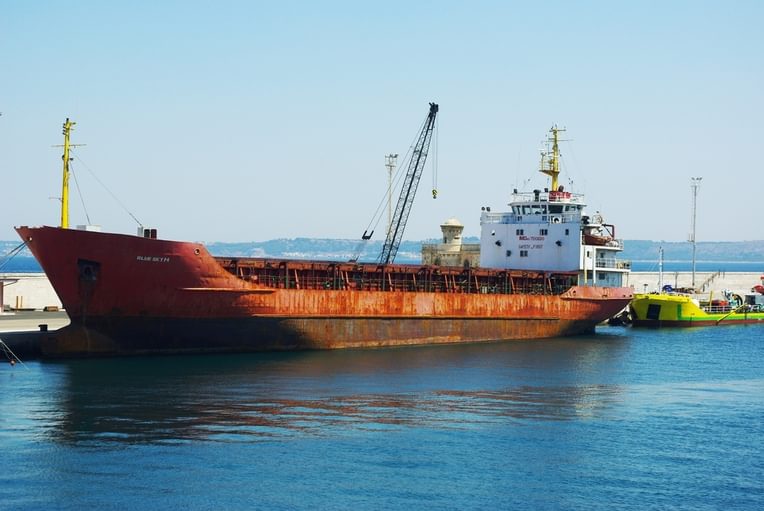Hollow Captivity: Pushing against the Wall
From the Series: Captivity
Gasoline and seawater may burn your skin when you are crammed in the human smugglers’ dinghy. Trapped in a ship’s hold, there will be no grave. The freight may crush you when you hide in a commercial truck. Jumping on top of a moving train may leave you dismembered. Smugglers might turn into traffickers, and their safe house into torture. There might not be enough oxygen, if you have to sail as a stowaway.
You know some of the risks beforehand, but you also know that the boat, the ferry, and the steel container serve as nested vessels, making their way through an intermodal and transnational network of cranes, docks, marine highways, tunnels, trucks, and railroads. The sea is never still. It carries things and itself. It carries people toward a horizon emerging out of the situational interplay of power, agency, circumstance, and chance.

If there is no lethal shipwreck, there is likely some form of captivity. “I’ll think how I’d like to get inside the wall,” Jean-Paul Sartre (1975, 8) wrote in a celebrated short story. “I’ll push against it with my back . . . with every ounce of strength I have, but the wall will stay, like in a nightmare.” Of course. No one can push against a wall by herself.
Border walls, fences, barriers, watchtowers, surveillance technology, transnational registries, social networks, check points, processing facilities, and detention centers figure as conspicuous expressions of an entrenched regime (and ideology) of sovereignty and migration. This regime is implemented through a vast infrastructure, including mass detention and removal; an exponential growth in public spending for border militarization; and the asymmetrical collaboration of transit and origin countries, intended to preempt emigration and to secure readmission agreements. Passenger airliners deport people to reluctant countries of origin (presumed countries of origin, sometimes). Commercial ferries are repurposed as floating detention facilities, if need be. Navy vessels may intercept, rescue, and push back a migrant boat in distress. There is a productive “metastasis of punitive architecture,” as Chris Garces aptly puts it in his contribution to this session. Captivity is crucial to the resilient, adaptive, just-in-time qualities of sovereignty in the early twenty-first century.
As anthropologists, we grapple with fences and food, gates and hospitality, police batons and medical stretchers, lifeboats and surgical masks, military trucks and ambulances. The entanglements of captivity, care, and coercion, noted in Carolyn Sufrin’s intervention, demand skilled ethnographic scrutiny. These entanglements also demand urgent political scrutiny. One of the ways migration is globally managed is through the seemingly commonsensical claim that there is an inherent difference between provisionally deserving asylum seekers and unacceptable economic migrants. In reality, I have seen that the threat, procedure, and trespassing of captivity is integral to the policing/humanitarian mechanisms performing such a moral adjudication. Indeed, for an Italian speaker such as myself, the multifaceted condition of captivity is disturbingly implicated in the moral ascription of cattiveria. Cattivo is the qualifier of choice if one wants to refer, without frills, to bad guys, bad dogs, undisciplined children, threatening wolves, unwelcome thoughts, spoiled food, and anything or anyone who might be a captive of the devil himself—this is the political-theological etymology of cattivo.
The wall produces simplistic distractions, then. While sovereignty grounds some of its cultural credibility in the spatialization of social and economic relationships, its actual workings are more diffuse than what the invocation of a static wall might convey.
Always on the verge of “collapse,” as Chris Garces writes, the contradictions and inequalities of captivity may reemerge with each and every captive person, especially in administrative detention settings. Authorities procrastinate by acting relentlessly, arguably on behalf of the larger polity. When faced with the contradictions of migrant detention, they intensify surveillance, confinement, and individualization—outsourcing management to private entities, creating a Chinese-box succession of locks and gates, cutting down outdoor smoke time, opting for nonflammable mattresses, bolting beds and cabinets to the floor, confiscating anything sharp, liberally administering anxiolytics, and restricting independent oversight. “I enjoyed more rights in prison than here,” I have often heard in Italian immigration facilities.
Vessels continue to travel, constituting the intermodal network of sovereignty, migration, and global capitalism. People are detained, identified, processed; some are pushed back, repatriated, deported; others are not even allowed onboard. Will captive migrants lose sight of their mobile horizon? Will they resign themselves, reduce their thoughts “to those of a prisoner” (Camus 1989, 77), and thus be disciplined into an uneventful routine dotted, when not dictated, by physiological and bureaucratic needs? Will the ever-stretching temporality of boredom constitute the occasion for unexpected insubordination and flight? Will journalists, judges, lawyers, anthropologists, or other migrants and citizens stand by the captives’ side, pushing against new walls, countering the ideology of diffuse captivity with everyday practices of diffuse reception? Passenger airliners will keep deporting their migrant captives. Before takeoff can materialize, though, all passengers must cooperate with cabin crew. What would it take for me to refuse to fasten my seatbelt, and in so doing to publicly stray from moralizing captivity?
Camus, Albert. 1989. The Stranger. Translated by Matthew Ward. New York: Vintage International. Originally published in 1942.
Sartre, Jean Paul. 1975. The Wall (Intimacy) and Other Stories. Translated by Lloyd Alexander. New York: New Directions. Originally published in 1948.